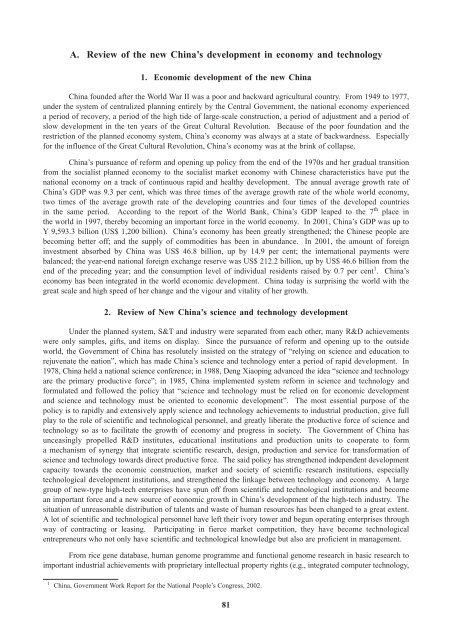iii. promoting business and technology incubation for ... - Escap
iii. promoting business and technology incubation for ... - Escap
iii. promoting business and technology incubation for ... - Escap
You also want an ePaper? Increase the reach of your titles
YUMPU automatically turns print PDFs into web optimized ePapers that Google loves.
A. Review of the new China’s development in economy <strong>and</strong> <strong>technology</strong><br />
1. Economic development of the new China<br />
China founded after the World War II was a poor <strong>and</strong> backward agricultural country. From 1949 to 1977,<br />
under the system of centralized planning entirely by the Central Government, the national economy experienced<br />
a period of recovery, a period of the high tide of large-scale construction, a period of adjustment <strong>and</strong> a period of<br />
slow development in the ten years of the Great Cultural Revolution. Because of the poor foundation <strong>and</strong> the<br />
restriction of the planned economy system, China’s economy was always at a state of backwardness. Especially<br />
<strong>for</strong> the influence of the Great Cultural Revolution, China’s economy was at the brink of collapse.<br />
China’s pursuance of re<strong>for</strong>m <strong>and</strong> opening up policy from the end of the 1970s <strong>and</strong> her gradual transition<br />
from the socialist planned economy to the socialist market economy with Chinese characteristics have put the<br />
national economy on a track of continuous rapid <strong>and</strong> healthy development. The annual average growth rate of<br />
China’s GDP was 9.3 per cent, which was three times of the average growth rate of the whole world economy,<br />
two times of the average growth rate of the developing countries <strong>and</strong> four times of the developed countries<br />
in the same period. According to the report of the World Bank, China’s GDP leaped to the 7 th place in<br />
the world in 1997, thereby becoming an important <strong>for</strong>ce in the world economy. In 2001, China’s GDP was up to<br />
Y 9,593.3 billion (US$ 1,200 billion). China’s economy has been greatly strengthened; the Chinese people are<br />
becoming better off; <strong>and</strong> the supply of commodities has been in abundance. In 2001, the amount of <strong>for</strong>eign<br />
investment absorbed by China was US$ 46.8 billion, up by 14.9 per cent; the international payments were<br />
balanced; the year-end national <strong>for</strong>eign exchange reserve was US$ 212.2 billion, up by US$ 46.6 billion from the<br />
end of the preceding year; <strong>and</strong> the consumption level of individual residents raised by 0.7 per cent 1 . China’s<br />
economy has been integrated in the world economic development. China today is surprising the world with the<br />
great scale <strong>and</strong> high speed of her change <strong>and</strong> the vigour <strong>and</strong> vitality of her growth.<br />
2. Review of New China’s science <strong>and</strong> <strong>technology</strong> development<br />
Under the planned system, S&T <strong>and</strong> industry were separated from each other, many R&D achievements<br />
were only samples, gifts, <strong>and</strong> items on display. Since the pursuance of re<strong>for</strong>m <strong>and</strong> opening up to the outside<br />
world, the Government of China has resolutely insisted on the strategy of “relying on science <strong>and</strong> education to<br />
rejuvenate the nation”, which has made China’s science <strong>and</strong> <strong>technology</strong> enter a period of rapid development. In<br />
1978, China held a national science conference; in 1988, Deng Xiaoping advanced the idea “science <strong>and</strong> <strong>technology</strong><br />
are the primary productive <strong>for</strong>ce”; in 1985, China implemented system re<strong>for</strong>m in science <strong>and</strong> <strong>technology</strong> <strong>and</strong><br />
<strong>for</strong>mulated <strong>and</strong> followed the policy that “science <strong>and</strong> <strong>technology</strong> must be relied on <strong>for</strong> economic development<br />
<strong>and</strong> science <strong>and</strong> <strong>technology</strong> must be oriented to economic development”. The most essential purpose of the<br />
policy is to rapidly <strong>and</strong> extensively apply science <strong>and</strong> <strong>technology</strong> achievements to industrial production, give full<br />
play to the role of scientific <strong>and</strong> technological personnel, <strong>and</strong> greatly liberate the productive <strong>for</strong>ce of science <strong>and</strong><br />
<strong>technology</strong> so as to facilitate the growth of economy <strong>and</strong> progress in society. The Government of China has<br />
unceasingly propelled R&D institutes, educational institutions <strong>and</strong> production units to cooperate to <strong>for</strong>m<br />
a mechanism of synergy that integrate scientific research, design, production <strong>and</strong> service <strong>for</strong> trans<strong>for</strong>mation of<br />
science <strong>and</strong> <strong>technology</strong> towards direct productive <strong>for</strong>ce. The said policy has strengthened independent development<br />
capacity towards the economic construction, market <strong>and</strong> society of scientific research institutions, especially<br />
technological development institutions, <strong>and</strong> strengthened the linkage between <strong>technology</strong> <strong>and</strong> economy. A large<br />
group of new-type high-tech enterprises have spun off from scientific <strong>and</strong> technological institutions <strong>and</strong> become<br />
an important <strong>for</strong>ce <strong>and</strong> a new source of economic growth in China’s development of the high-tech industry. The<br />
situation of unreasonable distribution of talents <strong>and</strong> waste of human resources has been changed to a great extent.<br />
A lot of scientific <strong>and</strong> technological personnel have left their ivory tower <strong>and</strong> begun operating enterprises through<br />
way of contracting or leasing. Participating in fierce market competition, they have become technological<br />
entrepreneurs who not only have scientific <strong>and</strong> technological knowledge but also are proficient in management.<br />
From rice gene database, human genome programme <strong>and</strong> functional genome research in basic research to<br />
important industrial achievements with proprietary intellectual property rights (e.g., integrated computer <strong>technology</strong>,<br />
1 China, Government Work Report <strong>for</strong> the National People’s Congress, 2002.<br />
81
















